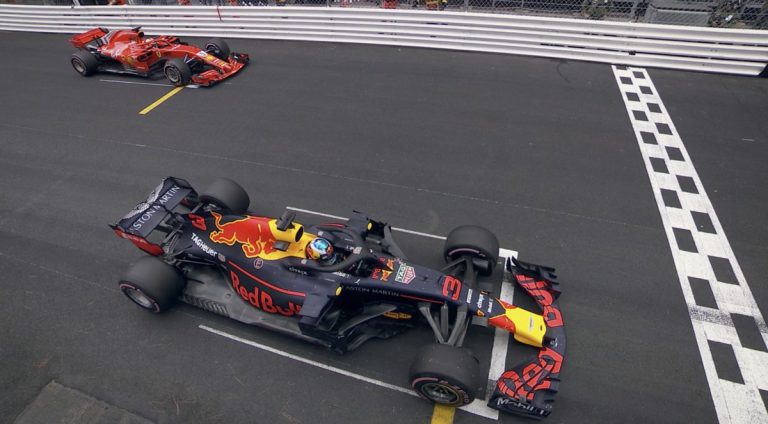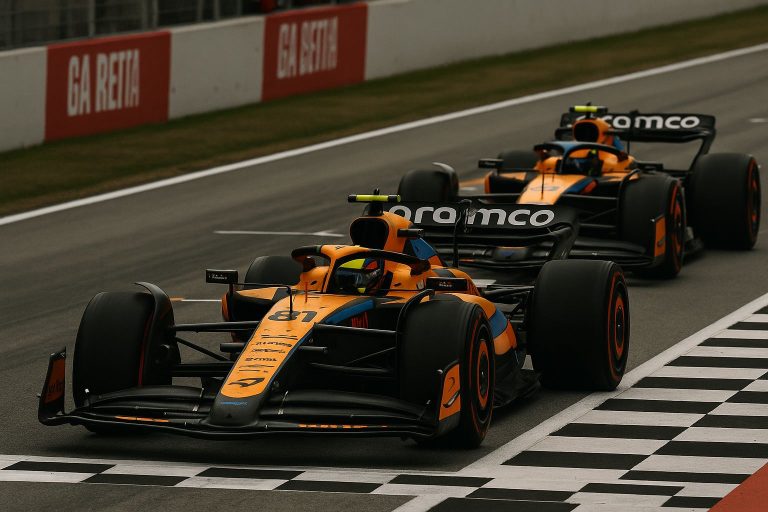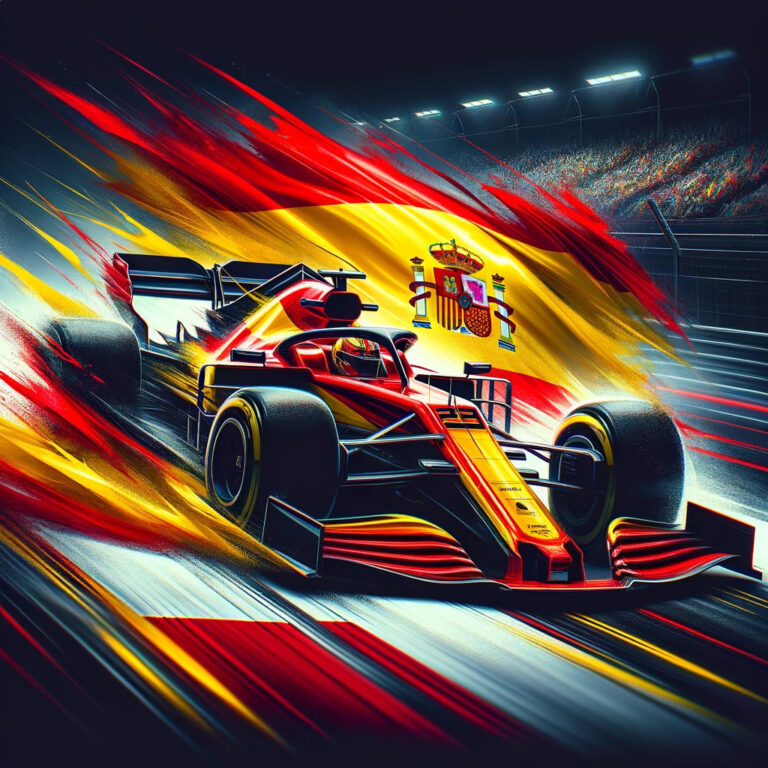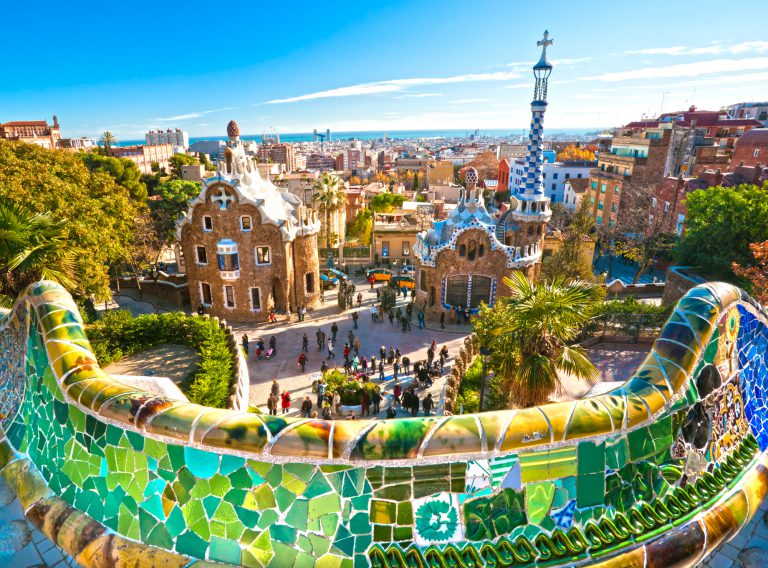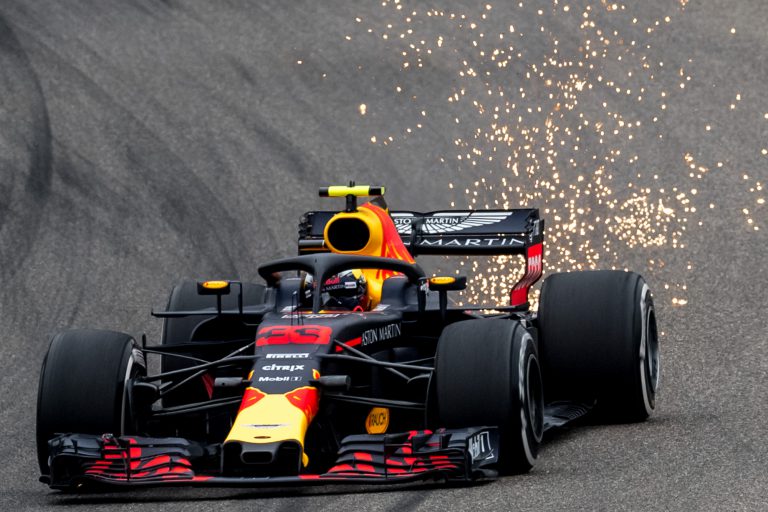Spain’s Formula 1 History of Race Tracks, Teams, and Drivers

TABLE OF CONTENTS
The beautiful country of Spain has been hosting Grand Prix events for over one hundred years dating all the way back to 1913. Formula 1 in Spain officially began in 1951 and has offered numerous exciting moments at its Grand Prix.
Excluding the tracks used before the inception of F1, over the years drivers and fans have seen five different tracks being used since the 50s. The current home of F1 is in the world-famous city of Barcelona at the Circuit de Barcelona-Catalunya wherein 2022 drivers will race from May 20th to the 22nd.
Spain has also produced fifteen drivers in F1 history but there is only a small handful of them who have reached the podium. Fernando Alonso is the most successful driver from Spain winning two driver’s championships with Renault in 2005 and 2006.
Alonso is currently driving for the French team Alpine F1 2022 season, but he is not the lone Spaniard on the grid. Carlos Sainz Jr, who drives for Ferrari, will also be on the grid for the 2022 season and in his young career, he has already produced promising results.
When it comes to Spanish F1 teams, Spain has not been able to produce more than one team in F1 history which competed for only two seasons. Let’s take a deeper look at all the Formula 1 tracks, teams, and drivers Spain has offered the world throughout history.
TRACKS
BEFORE FORMULA 1
Dating all the way back to the early 1900’s Spain has hosted numerous Grand Prix-style races using mostly road circuits for drivers to compete on. In 1913 at Guadarrama drivers had to endure a three-hundred-kilometer road circuit in order to cross the finish line.
In sharp contrast to the long multi-city circuit of Guadarrama, a Grand Prix was held at Sitges-Terramar in 1923 on a two-kilometer track, which was the first to be called the Spanish Grand Prix. For the rest of the twenties, races were held at Circuito Lasarte, another road circuit that was nearly eighteen kilometers long.
Lasarte was only able to host races until 1935 when Spain was embroiled in their own civil war and World War 2 took over Europe. Like the rest of Europe racing had to be put on hold for over a decade.
QUICK JUMPS
FORMULA 1 BEGINS
CIRCUITO DE PEDRALBES
In 1951 Grand Prix racing finally returned to Spain, joining Formula to host its first race in Barcelona at the Circuito de Pedralbes. Pedralbes when looking from above looks like an arrowhead split in half from top to bottom having only six turns for drivers to contend with. The length of this street circuit was 6.333km requiring drivers to complete seventy laps to complete the race distance of 442.120km.
Drivers began the race on a long straight leading into turn 1 which is a tight hairpin before heading into the second-longest straight of the race leading up to turns 2-3 which consisted of a slight left-hand bend that culminated with a second hairpin. Turn 4 was a sharp nearly 90-degree left-hander with turns 5 and 6 being another two sharp right-handers. Juan Manuel Fangio had the fastest lap with a time of 2:16.93 driving for Alfa Romeo.
A DANGEROUS VIEWING EXPERIENCE
It was a simple track that was loved by drivers but only hosted two races in the fifties. Financial difficulties forced the Spanish GP to sit out for a couple of seasons, returning to F1 in 1954 for the last time.
Pedralbes was a street circuit where fans lined the streets without any barriers to protect them from any dangers and after the devastating crash in LeMans in 1955 that killed 80 spectators, the Spanish circuit was deemed too dangerous. Financial woes, safety issues and having no real replacement for the track, the Spanish Grand Prix had to wait until 1968 to return.
CIRCUITO DEL JARAMA
In order for Spain to return to the Formula 1 schedule, they needed to prove that their new Jarama Circuit found north of Madrid would make the grade by holding an exhibition/test race in 1967. Formula 1 was satisfied, and the circuit became home to the Spanish GP from 1968 until 1981.
The GP alternated with the Montjuic circuit which we will cover next. Jarama was built in 1967 and was designed by Dutchman John Hugenholtz who also had a hand in designing Suzuka in Japan, Zolder in Belgium, and numerous other circuits.
INSIDE THE NUMBERS
Jarama’s original GP circuit consisted of fifteen turns that ran over a 3.404km of track. Race distances and the total laps have varied throughout the circuit’s use, which initially began with ninety laps for 306.360km until 1976.
In 1976 the lap total fell to seventy-five laps with a race distance of 255.3km. In 1981 the lap count jumped up by five to eighty laps and in the final race, it would host in F1 the distance achieved was 264.96km. Gilles Villeneuve had the fastest lap on the circuit in 1981 with a time of 1:16.44 driving for Ferrari.
NOT MUCH ROOM TO MANEUVER
Jarama was an arduous track for drivers attempting to overtake their rivals on this narrow and twisting track. The circuit had six hairpins varying in size and degrees while also including three sharp nearly ninety-degree turns. Ultimately the tight nature of the circuit would trigger the withdrawal of the circuit from Formula 1 whose cars were getting too big for the track.
MONTJUÏC CIRCUIT
The Spanish GP from 1968 until 1975 alternated between two tracks, the first being Jarama near Madrid and the second in Montjuic near Barcelona. Unlike Jarama, Montjuic was a street circuit using the roads that went around the Montjuic mountain. The history of the circuit being used dates back to the thirties and made its first F1 appearance in 1969.
INSIDE THE NUMBERS
The circuit ran counterclockwise and had a track length of 3.791km which included eleven turns for drivers to contend with. Drivers needed to complete seventy-five laps to attain the race distance of 284.25 to complete the race.
The circuit had an interesting setup where half the track drivers could attain very fast speeds contending with long gradual curves. The other half of the track was slower with multiple braking points so drivers could maneuver some hairpins and sharp left-handed turns.
Finding the right configuration of downforce and top speed was a challenge for teams and drivers attempting to find the right balance so they can perform maximally throughout the entire course. The fastest lap was set by Sweden’s Ronnie Peterson driving for Lotus in 1973 with a time of 1:23.80.
SAFETY ISSUES STRIKE ONCE AGAIN
Only four races took place in Montjuic due to driver complaints about safety on the narrow track that had unfastened barriers surrounding the circuits. In 1975 drivers threatened not to race on the circuit and if they had followed through with their threat perhaps some lives would have been saved.
On lap 26 an accident occurred when an errant rear wing forced the race car to spin out and fly into the crowd killing four fans, the race was stopped on lap 29. It was a tragic end to the Montjuic circuit in Formula 1.
CIRCUITO DE JEREZ
From 1982 to 1985 the Spanish Grand Prix was no longer on the F1 schedule only to make its return in 1986 in the city of Jerez. The Jerez circuit was a permanent track and was inspired by Alessandro Rocci and engineer Manuel Medina Lara made it come to life.
Unfortunately for Jerez, which was located south of Seville, was very remote and would ultimately create poor attendance numbers, forcing the Spanish GP to relocate once again in 1991.
INSIDE THE NUMBERS
To complete a lap, drivers needed to drive 4.218km and had to maneuver through sixteen turns. To reach the chequered flag, drivers needed seventy-three laps to achieve the race distance of 307.918km. The fastest lap was scored by Italian Ricardo Patrese in 1990 driving for Williams with a time of 1:24.513.
Jerez, like most of the other circuits used in Spain, presented drivers with many sharp corners and multiple hairpins requiring them to stay focused and sharp the entire race. Although Jerez was removed from F1 in 1991, it did make a return, hosting the European Grand Prix in 1994 and 1997.
MORE TROUBLE IN SPAIN
Jerez was slightly altered adding a new chicane wherein 1990 Martin Donnelly nearly lost his life in an accident. Germany’s Heinz Herald Frentzen in 1997 had the fastest lap with a time of 1:23.135 driving for Williams. Jerez, like its predecessors, did not last long on F1 schedules making way for the current and longest-standing home of the Spanish Grand Prix in Catalunya.
CIRCUITO DE BARCELONA-CATALUNYA
In 1991 Barcelona became the home of the Spanish Grand Prix and has hosted the race ever since then. Being located in one of the most vibrant and popular cities in the world, Formula 1 has no problem filling up the one hundred forty thousand and seven hundred available seats in the stands. If Lionel Messi were to drive an F1 car I am sure they could double their attendance.
TESTING GROUNDS
The circuit has been modified for Formula 1 and MotoGP six times with the hopes of creating a more exciting race that actually could have drivers overtaking each other. The layout of the track is not the only reason why overtaking is not commonplace but also because the circuit is used as a test site during the offseason. Drivers become extremely familiar with the track testing their cars, therefore when it comes to racing errors are not likely, which in turn reduces the chance for overtakes.
INSIDE THE NUMBERS
The current layout of the track features sixteen turns on a track that is 4.675km long. Drivers need to complete sixty-six laps to reach the race distance of 308.424km. The current layout holds true to Spain’s history of tracks featuring multiple hairpins but has withheld any sharp ninety-degree turns.
The current circuit has two DRS zones, the first between turns 8 and 9 and the second between turns 15 and 16 heading into the final straight towards the finish line. The Spanish GP in Barcelona has had its contract extended until 2026.
Listed below is the table I have listed the different track layouts with their respective fastest laps and relevant information.
| CIRCUIT | LAP LENGTH | TURNS | TOTAL LAPS | RACE DISTANCE | FASTEST LAP | DRIVER-TEAM-YEAR |
| 1991-1993 | 4.747KM | 14 | 65 | 308.414KM | 1:20.989 | MICHEAL SHCUMACHER-BENETTON-1993 |
| 1994 | 4.745KM | 14 | 65 | 308.414KM | 1:25.155 | MICHAEL SCHUMACHER-BENETTON-1994 |
| 1995-2003 | 4.730KM | 13 | 65 | 307.324KM | 1:20.143 | RUBENS BARRICHELLO-FERRARI-2003 |
| 2004-2006 | 4.627KM | 14 | 66 | 305.256KM | 1:15.641 | GIANCARLO FISICHELLA-RENAULT-2005 |
| 2007-2020 | 4.655KM | 16 | 66 | 307.104KM | 1:18.183 | VALTTERI BOTTAS-MERCEDES-2020 |
| 2021- | 4.675KM | 16 | 66 | 308.424KM | 1:18.149 | MAX VERSTAPPEN-RED BULL-2021 |
TEAMS
Spain is world-class when it comes to producing amazing teams in soccer on both the national and international levels. Teams that play in Spain’s La Liga like Barcelona, Real Madrid, Atletico Madrid, and Valencia have made their names known across Europe and the world.
Unfortunately, when it comes to Formula 1, Spain has only been able to produce a team in F1 history and there do not seem to be any other Spanish teams entering the fray anytime soon. Let’s take a look at the sole Spanish team to ever compete in Formula 1.
HRT FORMULA 1 TEAM
From the very beginning of its founding, HRT had a shaky foundation that would not bode well for longevity in Formula 1. HRT was originally created under the moniker of Campos Racing named after its founder Adrian Campos in Madrid.
In 2009 Campos recruited the help of many investors including Jose Ramon Carabante and Pau Gasol to help support the team’s bid to join F1. Campos racing acquired the use of the Italian-made Dallara chassis running on Cosworth engines.
DOOMED FROM THE START
Financial struggles immediately came to harm the team, which eventually led to Campos selling the team before ever stepping out onto a racetrack. The team was bought out by co-investor Jose Ramon Carabante who made his fortunes in property management and running a professional Spanish basketball team CB Murica.
Carabante changed the name of the team to Hispania Racing Formula One Team and even did not last more than a season running the team. In 2011 HRT shifted from Dallara to Toyota and in mid-season, the team was sold to Thesan Capital, a Spanish investment firm based in Madrid.
In 2012 the unraveling of the team began with the team being unable to qualify for the Australian GP and was subsequently put up for sale. HRT could meet the deadline for the team to find new ownership and never returned to Formula 1 after the 2012 season.
SO MANY DRIVERS VERY FEW RESULTS
In its two seasons of racing HRT was unable to produce any positive results on the track and had a remarkable number of drivers who took the wheel for the team. HRT had eight different drivers which definitely did not help develop any cohesion in the paddock. The team’s best performance was in 2011 when Italy’s Vitantonio Liuzzi finished in thirteenth place at the Turkish Grand Prix.
F1 STATS
- RACED FROM: 2010-2012
- RACES: 56
- CONSTRUCTORS CHAMPIONSHIPS: 0
- DRIVERS CHAMPIONSHIPS: 0
- WINS: 0
- PODIUMS:0
- TOTAL POINTS: 0
- POLE POSITIONS:0
- FASTEST LAPS: 0
DRIVERS
We know that Spain has produced world-class soccer teams and we also know they have produced world-class soccer players as well. Sergio Ramos, Andres Iniesta, and Xavi Hernandez are some that come to mind but when it comes to Formula 1 Fernando Alonso is a name that will forever stand out.
Spain throughout Formula 1 history has seen fifteen drivers compete with only a small handful stepping up to the podium out of that group. The very first driver from Spain to race in Formula 1 was Paco Godia in 1951 at the Spanish Grand Prix. Below we take a look at some of Spain’s best F1 drivers who have made their mark in motorsport.
QUICK JUMPS
FERNANDO ALONSO
Fernando Alonso Diaz who was born in the city of Oviedo found in the principality of Asturias in Spain on July 29th, 1981 is the only Spanish World Driver’s Champion in F1 history. Alonso started karting at the age of three ingraining racing habits into him. His family did all they could to support Alonso despite not having the finances to fully pursue the sport.
A WINNER FROM THE START
Nonetheless, Alonso continued to win races and eventually won some junior championships, helping him get much-needed sponsorships and mentorship. By the time he was seventeen, Alonso had become a promising prospect and in 1999 he competed in the Euro Open by Nissan racing cars instead of karts and won the championship by season’s end. Before taking the monumental leap to Formula 1, Alonso in the year 2000 competed in Formula 3000 finishing in fourth place for the driver’s title.
JOINING F1
In 2001 Alonso joined the big boys in F1 racing for Minardi and despite having a weaker car, was able to produce a top ten finish during the season. Flavio Briattore of Renault signed Alonso to be a test driver in 2002, keeping the Spaniard off the track for that season.
In 2003, Alonso returned to compete in F1 with Renault and showed the world his impressive skills, claiming multiple pole positions and winning his first race in Hungary. Alonso’s four podiums left him ranked sixth for the drivers’ championship in his second full year of racing.
A WORLD CHAMPION
Alonso continued to grow in 2004 but it would be in 2005 that he would make history for Spain and Formula 1 becoming the youngest driver to claim a world championship. Alonso won seven races, claimed six pole positions, and stood on the podium a total of fifteen times. In 2006 Alonso was heavily favored to win back-to-back championships but had someone by the name of Michael Schumacher in his way.
Alonso began the season dominating the championship but was eventually slowed down by new regulations giving Schumacher a chance to compete against him. The championship was decided in the last race of the season and Alonso became the youngest driver to ever win back-to-back titles.
JOINING MCLAREN AND FERRARI
Alonso didn’t sit still moving to McLaren for one year in 2007 managing to finish third for the driver’s title and create a bitter rivalry with Lewis Hamilton. Alonso left McLaren to rejoin Renault in 2008 and 2009 and could not score more than two wins during that time.
Ferrari came calling in 2010, giving the Spaniard an opportunity to compete for championships finishing in second place for the title three times in 2010,2012, and 2013. Expectations were for Alonso in Ferrari, but the dynamic duo could never win a much-needed championship.
From 2015 to 2018 Alonso drove for McLaren once again but the team was no longer at par with the front of the pack leaving Alonso in a struggling car scoring no victories during that time.
24 HOURS OF LE MANS
In 2018 Alonso may have struggled with McLaren but he did manage to win the 24 Hours of Le Mans opening the door for an attempt at the triple crown of racing. Alonso had won in Monaco, and LeMans, and all he needed was an Indy 500 win to complete the feat that only Graham Hill was able to accomplish many years ago.
Alonso made three attempts to win an Indy 500 but failed to finish any higher than 21st. Alonso left Formula 1 in 2019 altogether and won his second Lemans title.
HE STILL HAS THE GOODS
Alonso returned to the delight of fans to F1 in 2021 driving for Alpine as a forty-year-old. An old man compared to the young field of drivers around him but that could not stop Alonso from scoring points in more than half the races on the schedule and scoring a third-place finish in Qatar.
Alonso will compete for at least one more season with the improving Alpine team in 2022. Alonso is considered one of the best drivers of all time who has a unique driving style that few drivers can ever hope to match. Alonso is the only Spanish driver to have world titles and races in F1’s history.
F1 STATS
- RACED FROM: 2001-2018, 2021-
- TEAMS: FERRARI, RENAULT, MCLAREN, MINARDI, ALPINE
- RACES: 336
- CHAMPIONSHIPS: 2 (2005,2006)
- WINS: 32
- PODIUMS:98
- TOTAL POINTS:1980
- POLE POSITIONS:22
- FASTEST LAPS: 23
CARLOS SAINZ JR
Carlos Sainz Vasquez de Castro, who was born on September 1st, 1994 in Madrid, Spain, is the second most successful Spanish driver in F1 history driving currently for Ferrari. Motorsport and racing are a family affair in the Sainz household because Sainz’s father was a two-time Rally World Champion and his uncle a rally driver as well. It would seem that Sainz was destined to be a rally star, but he has never competed in a professional rally race to date.
Sainz had an excellent start to his karting career, which began when he was eight years old. Throughout his four-year run in professional karting, Sainz managed to finish in the top three competing in different cups and championships eight times, including two 1st place finishes.
STRONG POTENTIAL
In 2010 Sainz graduated from karting and moved up to single-seaters competing across multiple series of racing that included Formula BMW, Formula Renault, and F3 Open. Sainz in 2011 had an excellent season winning the Formula Renault 2.0 NEC championship and finishing runner up in the EuroCup Formula Renault 2.0.
Sainz could only keep moving upward and forward heading to various Formula 3 series racing in seventy-two races in 2012. In 2014 Sainz won his last championship racing in the “lower leagues” winning the Formula Renault 3.5 Series which was sufficient for Formula 1 to take heed of the Spaniard’s talent.
TORO ROSSO COMES CALLING
Toro Rosso, who has a great history of fielding future great drivers, decided to add Sainz to their stable in 2015. Sainz with Toro Rosso could not achieve any podiums but certainly showed he can finish in the top ten in multiple races. He remained with Toro Rosso from 2015 until 2017 when he finished the last four races of the season with Renault.
With Renault Sainz continued to be consistently in the top 10 of races and by season’s end he was able to finish in tenth for the driver’s title. Sainz’s time in Renault was brief and in 2019 he joined McLaren becoming an even steadier competitor with a much better car.
MAKING A NAME FOR HIMSELF
Sainz achieved the first podium of his career in Brazil, finishing in third place. In 2020 Sainz emerged as one of the top drivers in Formula 1, seldom finishing races above eight places, the Spaniard also claimed his first second-place finish at the Italian Grand Prix.
SMOOTH OPERATOR
In 2021 Sainz left McLaren for Ferrari and completed his best season to date reaching the podium four times in Monaco, Hungary, Russia, and Abu Dhabi. Sainz looked impressive with Ferrari and was dubbed as the “smooth operator” named after his smooth driving skills.
Sainz finished fifth for the driver’s title and with Ferrari promising a much better car in 2022 perhaps Sainz will achieve his first victory in Formula 1.
F1 STATS
- RACED FROM: 2015-
- TEAMS: FERRARI, RENAULT, MCLAREN, TORO ROSSO
- RACES: 141
- CHAMPIONSHIPS: 0
- WINS: 0
- PODIUMS:6
- TOTAL POINTS:536.5
- POLE POSITIONS:0
- FASTEST LAPS: 1
PEDRO DE LA ROSA
Pedro Martinez de la Rosa who was born on February 24th, 1971 in Barcelona, Spain only managed to score one podium finish in one hundred and seven races. Pedro’s path to Formula 1 began unconventionally, beginning to race with remote-controlled cars and winning numerous championships along the way too.
A LATE BLOOMER
Pedro only began Karting at the age of seventeen and quickly proved he can race behind a steering wheel instead of a remote. When he was eighteen in 1989, he won the Spanish Formula Fiat Uno Championship and in 1990 won another championship in the Formula Ford.
Pedro continued to race in the nineties, competing in Formula Renault, Japanese Formula Three, Formula Nippon and competed in GT racing in Japan. Pedro was able to win five championships before entering Formula 1 in 1998 with Jordan as a test driver for the time.
ARROWS TAKES A SHOT
In 1999 it was showtime for Pedro to get into his first race driving for Arrows and in two seasons with the team scored three points. His best finish was finishing in sixth place three times in Australia, Nürburgring, and German GPs. Pedro began the 2001 season as test driver for Jaguar and by race five was back in the field returning to race in Spain.
AT LEAST HE GOT ONE
With Jaguar not much would change for the Spaniard only scoring points twice in two seasons. From 2003 to 2009 Pedro was without a seat and became a test driver for McLaren and only competed in nine races during that time. Despite the lack of opportunity Pedro did manage to have the best race of his F1 career, finishing in second place at the Hungarian GP. It was the first and last podium of his career.
THE TEST DRIVER
In 2010 Pedro returned to his role as a test driver but this time for BMW Sauber and tire manufacturer Pirelli. Pedro managed to get into fourteen races that year, scoring a meager 6 points. In 2011 you guessed it Pedro was a test driver back at McLaren and he participated in one race driving for Sauber.
In 2012 Pedro won a seat with HRT and competed in twenty races finishing nearly last in the standings and scoring no points. For the next two years, Pedro was hired by Ferrari to be a test driver of course and afterward never returned to race in Formula 1.
F1 STATS
- RACED FROM: 1999-2002,2005-2006, 2010-2012
- TEAMS: MCLAREN, ARROWS, JAGUAR, HRT, SAUBER
- RACES: 107
- CHAMPIONSHIPS: 0
- WINS: 0
- PODIUMS:1
- TOTAL POINTS:35
- POLE POSITIONS:0
- FASTEST LAPS: 1
ALFONSO DE PORTAGO
Alfonso has a full name that is more than a mouthful; his full name is Alfonso Antontio Vicente Eduardo Angel Blas Francisco de Borja Cabeza de Vacay y Leighton the 11th Marquess of Portago. Now say that ten times fast!
AN OLYMPIAN ARISTOCRAT
Alfonso was born on October 11th, 1928 in London, England, and was a descendant of Spanish royalty, hence the long name. Referred to as a thrill-seeking playboy, Alfonso loved to speed and enjoyed bobsleighing, riding horses and of course, racing cars. Alfonso created the first Spanish winter Olympic bobsleigh team and even managed to finish in fourth place at the 1956 Olympics in Italy.
NEED FOR SPEED
Alfonso began racing with Ferrari’s in 1953 and 1954 competing in South American and Tour de France races. Portago won multiple races and in 1956 he joined Ferrari in Formula 1 and became the first Spaniard to score a podium and points finishing in second place at the British Grand Prix.
A TERRIBLE WAY TO GO
In 1957 Alfonso was only able to compete in one race due to his untimely death competing in the Mille Miglia race in Italy. His crash not only killed himself, he killed his navigator and also maimed nine spectators in what was a gruesome crash leaving Alfonso split in half under the wreckage of his car. Alfonso was wild and daring and it was no surprise he died doing what he loved to do, racing.
F1 STATS
- RACED FROM: 1956-1957
- TEAMS: FERRARI
- RACES: 5
- CHAMPIONSHIPS: 0
- WINS: 0
- PODIUMS:1
- TOTAL POINTS:4
- POLE POSITIONS:0
- FASTEST LAPS: 0


